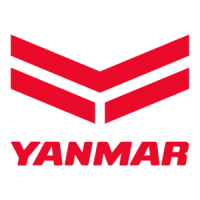
Do you have a question about the Yanmar 4JH3E and is the answer not in the manual?
| Engine Model | 4JH3E |
|---|---|
| Number of Cylinders | 4 |
| Aspiration | Naturally aspirated |
| Cooling System | Fresh water cooling with heat exchanger |
| Fuel System | Direct injection |
| Engine Type | 4-stroke, water-cooled, diesel |
| Bore x Stroke | 84 mm |
| Starting System | Electric |
| Lubrication System | Forced lubrication |
| Rotation | Counterclockwise, viewed from flywheel side |
A warning regarding diesel engine exhaust and its constituents.
Explains the meaning of various safety symbols used in the manual.
Essential safety instructions for operating and maintaining the engine.
Identifies the location and part numbers of warning labels on the engine.
Overview of engine application and drive system integration.
Information on identifying engine and marine gear by their nameplates.
Detailed technical specifications for various engine models.
Identifies and labels key components on the engine's operation and non-operation sides.
Lists and defines the function of essential parts for servicing and maintenance.
Details the components for remote operation, including the control panel.
Explains the operation of the optional Morse type single lever remote control.
Describes manual and electric methods for stopping the engine.
Guidelines for selecting and handling essential engine fluids.
Procedures to perform before the engine's first use, including fluid supply.
Procedure for distributing lube oil by cranking the engine before starting.
Steps for checking and refilling fluids after a trial engine run.
Daily inspections and checks required before starting the engine.
Step-by-step guide for starting the engine using the electric system.
Procedures for accelerating, decelerating, and engaging/disengaging the clutch.
Critical operational warnings to prevent damage or injury.
Steps for preparing the engine for extended periods of non-use.
Guidelines for performing periodic inspections and using genuine parts.
An overview of inspection and servicing tasks based on usage intervals.
Detailed procedures for initial inspections and maintenance tasks.
First-time replacement of engine oil, lube filter, and clutch lube oil.
Routine checks and maintenance performed every 50 operating hours.
Procedures for checking and adjusting remote control cable tension for proper operation.
Maintenance tasks including oil and filter replacement at 150-hour intervals.
Fuel filter replacement and V-belt tension adjustment at 300-hour intervals.
Procedures for replacing fresh water cooling and inspecting seawater pump parts.
Conditions and requirements for compliance with EPA emission standards.
Information about the engine's EPA certification plate and its attachment position.
Specifies surrounding conditions and fluids for meeting emission standards.
Specific inspection and maintenance tasks for EPA-related parts.
Troubleshooting steps when alarm indicators are active during operation.
Steps to take when the engine lube oil pressure warning lamp is illuminated.
Common causes and solutions for engine starting problems.
Diagnosing and addressing issues causing abnormal exhaust smoke colors.
Information on owner satisfaction and procedures for warranty claims and dealer interaction.
Key to symbols used in the piping diagrams.
Specific notes and clarifications regarding the piping diagrams.
Key for understanding wire colors used in electrical diagrams.
Details of engine models and their compliance with essential requirements.